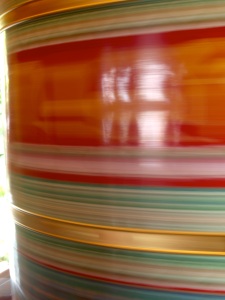All spent of Indonesian Rupiah, we flew out of Denpasar, Bali on 13th October on an Air Asia flight to Singapore.
I’m still in two minds about whether we left Bali at the right time or whether in hindsight I would have liked to have still been there for the 6.1 Magnitude earthquake which shook the island the morning after our departure.
Though similar in size to the fatal tremor that wrecked havoc in Christchurch earlier this year, relatively little damage was caused by this quake and injuries were minimal.
Friends who were still on Bali described the experience as a surreal and confusing one, but in the main, life returned to normality a few hours after the incident.
I guess I’ll have to rely on the 5.1 Mumbai rumble of 12 Dec 2009 for my sole experience of seismic shifts, though that was little more noticeable than the regular trembles one feels when living in the close vicinity of a London tube line, and I’m pretty sure I’ve created more powerful rubbles the morning after a night on the Deuchars IPA.
For our two days in Singapore we were hosted by Jan and Howie, a couple of former Mumbaiker expats who have now been based in the city for a few years.
The view from the 41st floor of their apartment block was stunning and at night-time offered an illuminated panorama of the city.
By day, Jan introduced us to some of the Temples of Singapore including a living Buddhist Museum inside which I discovered that being born in the year of the rat, I have a personal guardian buddha in the avatar of the 1,000 armed Avalokiteshvara.
I know buddhists eshew material wealth, but I can’t help thinking that Avalokiteshvara could make a good living as a Premier League goalie.
After visiting a quiet roof garden contained a fabulously large prayer wheel, we then wandered through a Hindu temple of colourful South Indian influence, where the boy, having found his feet a few days earlier was prone to pacing into areas demarcated solely for worshipers.
On this day, I suspect I may have been the only non-Indian adult to apparently be found paying homage at the foot of a giant marigold-wreathed cow.
Our next stop was the Malaysian port city of Malacca, a world heritage city that lends its name to the eponymous ship-laden straits that separate peninsular Asia from Sumatra.
Malacca has had a troublesome history over recent centuries, having been sequentially in the hands of the Malaccan Sultanate, the Portuguese, the Dutch and the British prior to Malaysian independence in 1957.
Much of what was built by the Portuguese has been destroyed, though the imposing ruins of “Fort a Formosa” still dominate the high ground overlooking the riverbank.
The Dutch built old town not only has the distinction of being painted in a uniform maroon colour, but also plays host to scores of tricycle rickshaws.
The trikes are pimped to the max with plastic flowers, garish designs and bright flashing lights, whilst each rider seems to be contracted by the local government to boom bad techno music from their enormous rear-facing speakers.
Naturally, we travelled shotgun in the most pimped ride we could find.
Following on from a river barge trip earlier in the day when we had spotted a monitor lizard nestling amongst the huge fortress slabs us Brits had used to construct a navigable river, the trike added yet another method of transport to “The Boy’s” already burgeoning collection of rides.
Trikes aside, Malacca also offered up yet another chance to taunt the cruel hand of fate.
Not content with running the volcano/quake gauntlet over the past month, this time it was food with which I was to play the proverbial Russian roulette as I popped my “Buah keluak” cherry.
The keluak is a tree native to the mangrove swamps of Southeast Asia. It produces a fruit known as the “football fruit” whose large seeds (similar in size to a chestnut) are so laden with hydrogen cyanide that they are often used as a powerful arrow poison.
These keluak nuts are deadly if consumed without undergoing the correct preparation.
To make safe for my consumption, the seeds would first need to be boiled and then buried in ash, banana leaves and earth for forty days.
After this lengthy process (fingers crossed) the hydrogen cyanide should have been released by the boiling and the fermented by-product easily washed out.
I didn’t have neither the time nor inclination to put my cooking through rigorous ISO standards, so what else then but to place my trust in the anonymous chef of The Riverine Café, Malacca, and order a bowl of ayam buah keluak, AKA chicken cooked with killer nuts.
The potentially fatal dish served involved me needing to fish my nuts out of a thick broth (yeah, yeah, don’t even think of going there…), before scooping a tar-like substance from inside the nut kernels that was then to be mixed with my rice, gravy and chicken pieces.
The bold taste of buah keluak is very difficult to describe, being powerfully pungent in one sense whilst softly aromatic in another. In a way it suggested a strong mushroom or perhaps truffle, yet was noticeably different from either.
All the same, the risk was worth it. I enjoyed it, and I lived to tell the tal…….





